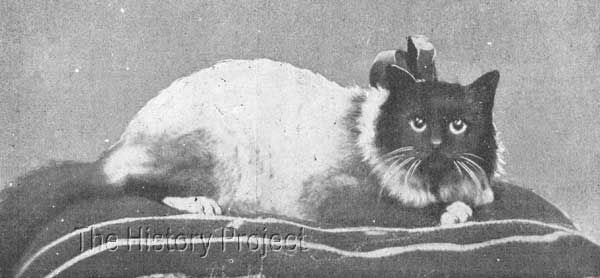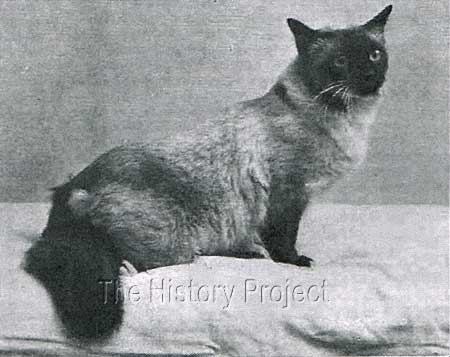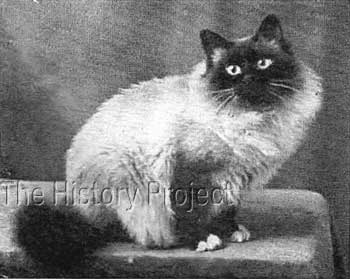 | ||||||||||||||||









|
BIRMAN
The Sacred Cat of Burma remains one of the most alluring of all the semi-longhair breeds. With their sapphire-blue eyes, pointed coat pattern and distinctly unique white gloves and spearheaded gauntlets, they assume a mystical, almost transcendental air; which has won them the admiration of millions of cat lovers worldwide. THE TEMPLE OF LAO-TSUN In his early writings about the breed, Dr. Jumaud, a French Veterinarian and Birman fancier, reports that the first recorded observation of these sacred temple cats was by British Army Major Russell Gordon, who had been charged with protecting the priests of the Khmer (known as Kittahs) in 1898. Major Gordon's account of the Temple, was that it was situated to the east of Lake Incaougji, between Magaoug and Sembo, in what was basically a desert region, surrounded by barriers and almost insurmountable walls. It was here where he was permitted to observe the last of the Kittahs with their sacred animals.
THE LEGEND The Legend of the Birman Cat 'Sinh', who sat on the bowed head of his deceased holy master 'Mun-Ha' before the Goddess Tsun Kyan-Kse, and was duly transformed from a yellow-eyed white cat to the golden hued, dark pointed, blue-eyed beauty with white feet, (where the feet came into contact with the body of his dead master), was related to Major Gordon by the Kittah-Lama, Yotag Rooh-Oughi, and later published in 'Minerva' by Dr. Fernand Mery. The story relates that on the seventh day 'Sinh' died, carrying to Tsun Kyan-Kse, the transmigrated soul of his holy master, 'Mun-Ha'. In an article published in La Vie A la Campagne in 1927, Dr. Jumaud describes the Birman cat in the following terms: "…the sacred Birman is very sociable, intelligent, happy to be stroked, obedient to commands, following his master in the same manner as a dog. He plays with composure, without the presence of his master he becomes nostalgic. He is a quiet animal and lacks the quickness and fire of the Siamese. He seems to be aware of his sacred origin."6 ARRIVAL IN FRANCE As to sequence of events leading to the arrival of the first Birman cats in the West, although not a legend, it is still shrouded in a degree of mystery, mostly due to a lack of documentary records, confusion over the names of the actual importers, and confusion over the possible outcrosses. Writing in 1926, Jumaud advises that the American millionaire, Vanderbilt, whilst cruising in his yacht in the Far East, obtained two cats, a male and a female, from an unfaithful servant who came from the temple of Lao-Tsun. It is assumed that the cats had been stolen. Mr. Vanderbilt is then reputed to have given the cats to a Mme Thadde Hadisch (Vienna). What is not clear, is whether this woman was behind the original purchase, or perhaps a guest of the Vanderbilts. But she soon disappears without a trace from the story. The two cats, appear to have been a male named 'MADALPOUR' and a female named 'SITA'. The male apparently died accidentally while at sea, although no details of his demise appear to be recorded, but it was subsequently discovered that the female, who did survive the journey, was already in kitten to him. The boat returned to France, and the female kittened her original litter in Nice, in 1920. From this litter one of the kittens (a female), was considered to be a perfect specimen and was named 'POUPEE'. This 'Poupee' was therefore the only recorded fully Birman offspring for which there is an oral record. What, we might wonder, happened to any of the other kittens that may have survived from this very precious litter!
FIRST OUTCROSSING In an article by Mr. Baudoin-Crevoisier in 1933, we are informed that "Poupee could not be bred by a male of that breed, but was bred to a Laotian Lynx cat belonging to a Doctor in Nice. This type of cat resembles the Siamese, with very blue eyes, and this breeding produced young mongrels of Birmans and Laotians. Through successive cross-breedings was born the perfect result - MANOU de MADALPOUR."3 No further mention is made of the original queen, 'SITA' or any further progeny from her, nor of alternative breedings, or of progeny from her daughter 'POUPEE'. The words 'successive breedings' is also open to interpretation, as it could mean repeat breedings OR alternative breedings and a number of generations. However, in 1933, the Swiss Abbot and breeder and author Marcel Chamonin (who wrote under the pseudonym of Marcel Reney), attempted to uncover the truth about this initial outcrossing of 'POUPEE' by writing directly to the famous doctor in Nice; who replied saying "We have had indeed several Siamese cats but know nothing of the origins. I know nothing of Mme Hadisch from Vienna."3 This would appear to affirm that the 'Laotian Lynx' was in fact a Siamese cat of "unknown pedigree". If we assume that the outcross was in fact an unregistered Siamese of unknown origin, we must also assume that this litter would have been comprised of all shorthaired kittens, unless the Siamese was already carrying the gene for long hair! It is in fact unclear as to whether 'MANOU de MADALPOUR' was from this breeding, or from a successive breeding but it is generally accepted that his dam was 'POUPEE'. He is also listed in Birman databases today, as from the 'Laotian Siamese' and 'POUPEE'.
Madame Marcelle Adams, who owned MANOU de MADALPOUR, affirmed to Marcel Reney that a certain Madame Leotardi, had related the Birman story as Jumaud and Baudoin had recorded it. It appears that she had obtained Manou from Madame Leotardi and photographs of this male and his mother 'Poupee' appeared in the 1st October, 1926 issue of Vie A La Campagne4 after they were successfully exhibited at a show in Paris in 1926 with the owners name recorded in the captions. ESTABLISHMENT Birman breeder, author, and former Chairman of the Birman Cat Club (GCCF) Vivienne Smith, gives us what is probably the best overview of the breeds development from those early years in her book The Birman Cat. "It is now up to the reader to draw their own conclusions from the above information and thus decide which gentleman/gentlemen actually acquired the original pair of Birman cats.3 "As can be seen, many articles and indeed, even a book by Marcel Reney - 'Los Amis Les Chats' have tried to investigate the true history of the Sacred Cat of Burma, but unfortunately much of the hstory is still shrouded with a seemingly impenetrable veil, particularly those years 1916-1935, and although undoubtedly, someone, somewhere in France knows the true story, we lesser mortals will have to use our imagination. All we can be certain of is that a considerable amount of inbreeding and the use of other breeds of cats must have occurred, as the Birmans as we know them today originated from this original pair of cats imported to France.3
"The Breed known as 'Sacre de Birmanie' was first recognized in France in 1925 by the Federation Feline Francaise' (the equivalent of England's G.C.C.F.) and in 1935 Monsieur Baudoin-Crevoisier, who was recognized as a top Birman breeder and who owned the well-known male 'Dieu d'Arakan' and a female 'Poupee,' whose photographs still exist in France today, decided to sell Dieu d'Arakan with six males and females to Princess Ratibor Hohenhole for the huge sum of 30,000 French francs, and these were subsequently bequeathed to the Duke d'Aosta. After a time these cats were then taken over by the Countess Giriode Panissera and the ownership transferred to her.3 "In the autumn of 1936 in the Castle of Francanvilla Bisio, near Noir Ligure, the result of all the Contessa's hard work was rewarded. Dieu d'Arakan and another male Reine de Rangoon sired seventeen Birmans in fourteen litters, and they became known as the most beautiful cats in the world at that time.3 RE-ESTABLISHMENT "Unfortunately, all the pedigree cats in Europe then suffered as a result of the second world war, and only two Birmans survived - one being the wonderful ORLOFF DE KAABAA, owned by Mlle Madeleine Boyer - to guarantee the existence of the Birman. By the early 1950's pure Birman litters were being produced and in 1955 once again achieved recognition as a pure breed."3
Since those times, 'The Sacred Cat of Burma' has grown from strength to strength, and is now a popular breed recognized universally world-wide. Birman cats can be found in almost every country of the world and can be counted as one of the most popular long-hair breeds of modern times. Their admirers are many, and their charm infectious. With their wonderful pointed coats, their gloved white feet and their azure blue eyes, they still impart an air of their holy and mysterious origins in the far off temple of Lao Tsun. BIRMAN HISTORIES(* = completed histories)
Registers associated with this article include The Incorporated Cat Fanciers Association of Great Britain (TICFAGB), National Cat Club (NCC), The Cat Club (CCR), Beresford Cat Club (BCC), Feline Federation Francaise (FFF), Siamese Cat Registry (SCR), US Register & Studbook for Cats (USR)including Supplement(USRS), The Studbook of the American Cat Association (ACA), and the Studbook & Register of the Cat Fanciers' Association (CFA).
|
|||||||||||||||
Home | Cats | Gallery | Clubs | People | Artifacts | Articles | Updates | Contact Us ©The CFA Foundation, Inc and The Harrison Weir Collection
|
||||||||||||||||






